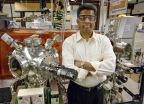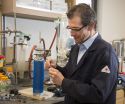(Press-News.org) In a development that holds promise for future magnetic memory and logic devices, researchers with the U.S. Department of Energy (DOE)'s Lawrence Berkeley National Laboratory (Berkeley Lab) and Cornell University successfully used an electric field to reverse the magnetization direction in a multiferroic spintronic device at room temperature. This demonstration, which runs counter to conventional scientific wisdom, points a new way towards spintronics and smaller, faster and cheaper ways of storing and processing data.
"Our work shows that 180-degree magnetization switching in the multiferroic bismuth ferrite can be achieved at room temperature with an external electric field when the kinetics of the switching involves a two-step process," says Ramamoorthy Ramesh, Berkeley Lab's Associate Laboratory Director for Energy Technologies, who led this research. "We exploited this multi-step switching process to demonstrate energy-efficient control of a spintronic device."
Ramesh, who also holds the Purnendu Chatterjee Endowed Chair in Energy Technologies at the University of California (UC) Berkeley, is the senior author of a paper describing this research in Nature. The paper is titled "Deterministic switching of ferromagnetism at room temperature using an electric field." John Heron, now with Cornell University, is the lead and corresponding author. (See below for full list of co-authors).
Multiferroics are materials in which unique combinations of electric and magnetic properties can simultaneously coexist. They are viewed as potential cornerstones in future data storage and processing devices because their magnetism can be controlled by an electric field rather than an electric current, a distinct advantage as Heron explains.
"The electrical currents that today's memory and logic devices rely on to generate a magnetic field are the primary source of power consumption and heating in these devices," he says. "This has triggered significant interest in multiferroics for their potential to reduce energy consumption while also adding functionality to devices."
Nature, however, has imposed thermodynamic barriers and material symmetry constrains that theorists believed would prevent the reversal of magnetization in a multiferroic by an applied electric field. Earlier work by Ramesh and his group with bismuth ferrite, the only known thermodynamically stable room-temperature multiferroic, in which an electric field was used as on/off switch for magnetism, suggested that the kinetics of the switching process might be a way to overcome these barriers, something not considered in prior theoretical work.
"Having made devices and done on/off switching with in-plane electric fields in the past, it was a natural extension to study what happens when an out-of-plane electric field is applied," Ramesh says.
Ramesh, Heron and their co-authors set up a theoretical study in which an out-of-plane electric field - meaning it ran perpendicular to the orientation of the sample - was applied to bismuth ferrite films. They discovered a two-step switching process that relies on ferroelectric polarization and the rotation of the oxygen octahedral.
"The two-step switching process is key as it allows the octahedral rotation to couple to the polarization," Heron says. "The oxygen octahedral rotation is also critical because it is the mechanism responsible for the ferromagnetism in bismuth ferrite. Rotation of the oxygen octahedral also allows us to couple bismuth ferrite to a good ferromagnet such as cobalt-iron for use in a spintronic device."
To demonstrate the potential technological applicability of their technique, Ramesh, Heron and their co-authors used heterostructures of bismuth ferrite and cobalt iron to fabricate a spin-valve, a spintronic device consisting of a non-magnetic material sandwiched between two ferromagnets whose electrical resistance can be readily changed. X-ray magnetic circular dichroism photoemission electron microscopy (XMCD-PEEM) images showed a clear correlation between magnetization switching and the switching from high-to-low electrical resistance in the spin-valve. The XMCD-PEEM measurements were completed at PEEM-3, an aberration corrected photoemission electron microscope at beamline 11.0.1 of Berkeley Lab's Advanced Light Source.
"We also demonstrated that using an out-of-plane electric field to control the spin-valve consumed energy at a rate of about one order of magnitude lower than switching the device using a spin-polarized current," Ramesh says.
INFORMATION:
In addition to Ramesh and Heron, other co-authors of the Nature paper were James Bosse, Qing He, Ya Gao, Morgan Trassin, Linghan Ye, James Clarkson, Chen Wang, Jian Liu, Sayeef Salahuddin, Dan Ralph, Darrell Schlom, Jorge Iniguez and Bryan Huey.
Lawrence Berkeley National Laboratory addresses the world's most urgent scientific challenges by advancing sustainable energy, protecting human health, creating new materials, and revealing the origin and fate of the universe. Founded in 1931, Berkeley Lab's scientific expertise has been recognized with 13 Nobel prizes. The University of California manages Berkeley Lab for the U.S. Department of Energy's Office of Science. For more, visit http://www.lbl.gov.
DOE's Office of Science is the single largest supporter of basic research in the physical sciences in the United States, and is working to address some of the most pressing challenges of our time. For more information, please visit the Office of Science website at science.energy.gov.
Premature ovarian failure, also known as primary ovarian insufficiency (POI), affects 1% of all women worldwide. In most cases, the exact cause of the condition, which is often associated with infertility, is difficult to determine.
A new Tel Aviv University study throws a spotlight on a previously-unidentified cause of POI: a unique mutation in a gene called SYCE1 that has not been previously associated with POI in humans. The research, published in the Journal of Clinical Endocrinology and Metabolism, was led by Dr. Liat de Vries and Prof. Lina Basel-Vanagaite of TAU's ...
A new species of short-necked marine reptile from the Triassic period has been discovered in China, according to a study published December 17, 2014 in the open-access journal PLOS ONE by Xiao-hong Chen from Wuhan Centre of China Geological Survey and colleagues.
Hupehsuchia is a group of mysterious Triassic marine reptiles which have, so far, only been found in two counties in Hubei Province, China. The group is known by its modestly long neck, with nine to ten cervical vertebrae, but the authors of this study recently discovered a new species of Hupehsuchia that may ...
A network of nine reference sites off the Australian coast is providing the latest physical, chemical, and biological information to help scientists better understand Australia's coastal seas, according to a study published December 17, 2014 in the open-access journal PLOS ONE by Tim Lynch from CSIRO, Australia and colleagues.
Sustained oceanic observations allow scientists to track changes in oceanography and ecosystems. To address this, the Australian Integrated Marine Observing System (IMOS) implemented a network of nine National Reference Stations (NRS). The network ...
Like human patients, mice with a form of Duchenne muscular dystrophy undergo progressive muscle degeneration and accumulate connective tissue as they age. Now, researchers at the Stanford University School of Medicine have found that the fault may lie at least partly in the stem cells that surround the muscle fibers.
They've found that during the course of the disease, the stem cells become less able to make new muscle and instead begin to express genes involved in the formation of connective tissue. Excess connective tissue -- a condition called fibrosis -- can accumulate ...
Bird migration is an impressive phenomenon, but why birds often travel huge distances to and from their breeding grounds in the far North is still very unclear. Suggestions include that the birds profit from longer daylight hours, or that there are fewer predators. Researchers from the University of Groningen and the NIOO-KNAW Vogeltrekstation, the Dutch centre for bird migration and demographics, have discovered a new explanation.
They investigated barnacle geese breeding on Spitsbergen and compared them with birds of the same species that did not migrate but stayed ...
DURHAM, N.C. -- The best way to protect wild spinner dolphins in Hawaii while also maintaining the local tourism industry that depends on them is through a combination of federal regulations and community-based conservation measures, finds a new study from Duke University.
Each year, hundreds of thousands of tourists to Hawaii pay to have up-close encounters with the animals, swimming with them in shallow bays the dolphins use as safe havens for daytime rest. But as the number of tours increases, so do the pressures they place on the resting dolphins.
The Duke study ...
A new catalytic process is able to convert what was once considered biomass waste into lucrative chemical products that can be used in fragrances, flavorings or to create high-octane fuel for racecars and jets.
A team of researchers from Purdue University's Center for Direct Catalytic Conversion of Biomass to Biofuels, or C3Bio, has developed a process that uses a chemical catalyst and heat to spur reactions that convert lignin into valuable chemical commodities. Lignin is a tough and highly complex molecule that gives the plant cell wall its rigid structure.
Mahdi ...
A close look at the night sky reveals that stars don't like to be alone; instead, they congregate in clusters, in some cases containing as many as several million stars. Until recently, the oldest of these populous star clusters were considered well understood, with the stars in a single group having formed at different times, over periods of more than 300 million years. Yet new research published online today in the journal Nature suggests that the star formation in these clusters is more complex.
Using data from the Hubble Space Telescope, a team of researchers at the ...
OAK RIDGE, Tenn., Dec. 17, 2014--Scientists at the Department of Energy's Oak Ridge National Laboratory have used advanced microscopy to carve out nanoscale designs on the surface of a new class of ionic polymer materials for the first time. The study provides new evidence that atomic force microscopy, or AFM, could be used to precisely fabricate materials needed for increasingly smaller devices.
Polymerized ionic liquids have potential applications in technologies such as lithium batteries, transistors and solar cells because of their high ionic conductivity and unique ...
UCLA researchers have developed a lens-free microscope that can be used to detect the presence of cancer or other cell-level abnormalities with the same accuracy as larger and more expensive optical microscopes.
The invention could lead to less expensive and more portable technology for performing common examinations of tissue, blood and other biomedical specimens. It may prove especially useful in remote areas and in cases where large numbers of samples need to be examined quickly.
The microscope is the latest in a series of computational imaging and diagnostic devices ...






